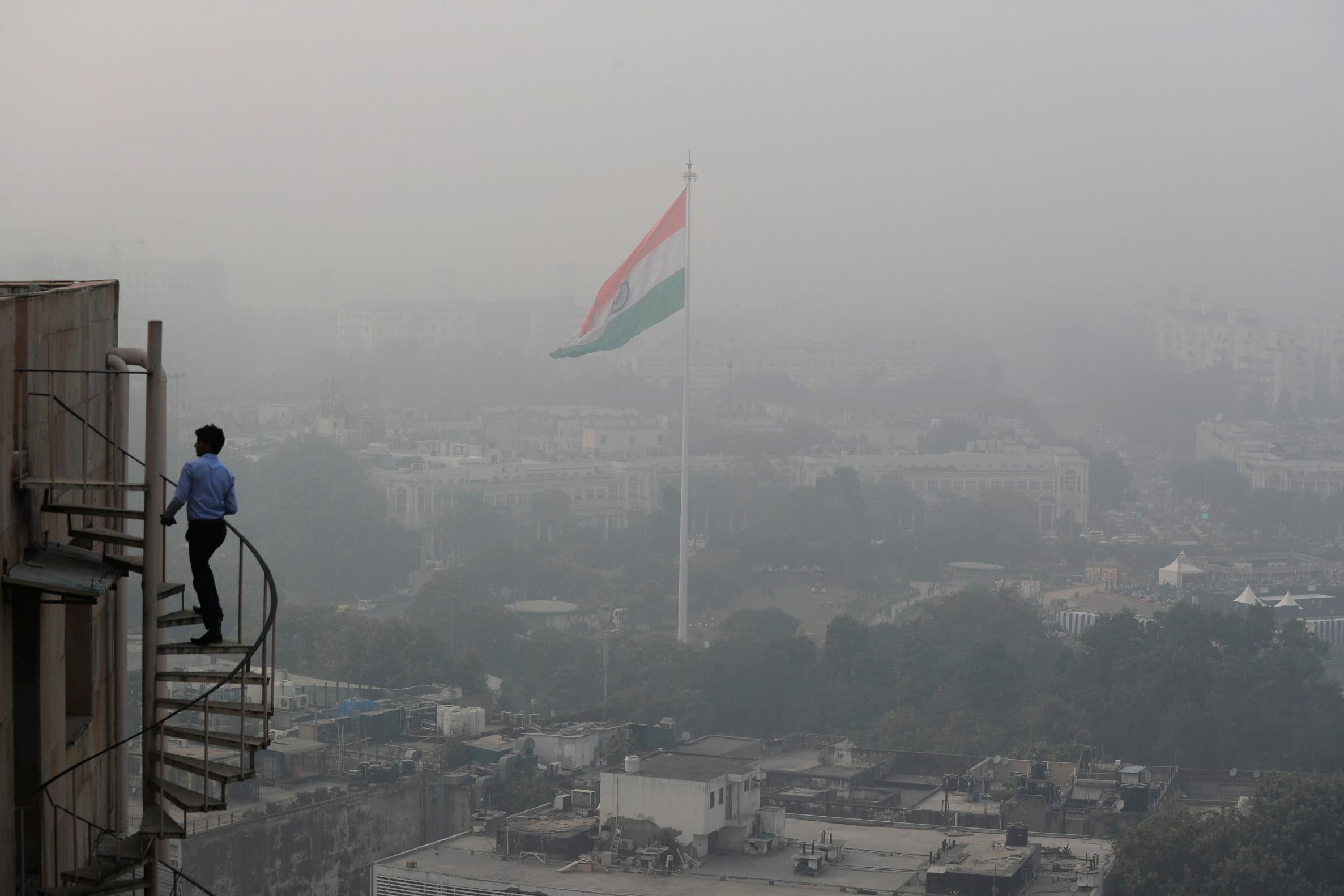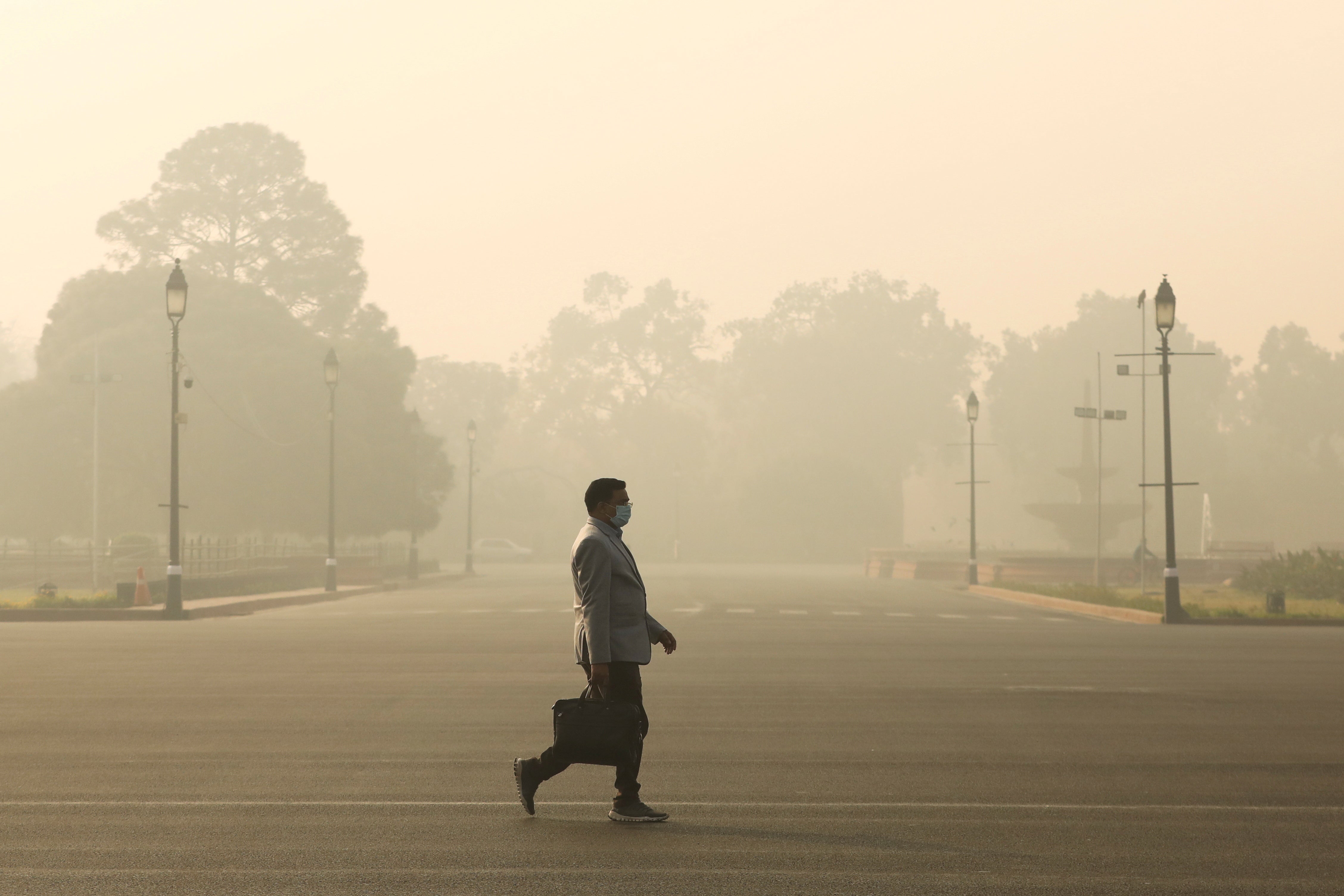‘Sounds like Doomsday’: Delhi gets set for ‘worst ever’ winter smog
As the Indian leader Narendra Modi attends the Cop26 summit, an annual environmental catastrophe is unfolding back home, reports Arpan Rai


A time bomb of pollution is ticking away in India’s northern belt, set to gradually explode in the next fortnight and turn the national capital New Delhi into a gas chamber, filling millions of lungs with hazardous air.
Satellite images show farm fires in two northern Indian states burning away, turning the air poisonous. Fields spread out hundreds of miles, running from Delhi to Haryana and then Punjab – the country’s rice bowls – will keep burning for the next 10 days or so. Acre by acre spanning more than 300 miles will be torched, to make space for the next batch of crops.
The fire and the smoke emanating from these farm fields, carried by winds, will travel to Delhi and mix with the city-state’s own ever-rising pollution.
On average, a person living in India’s national capital – the world’s most polluted city for three consecutive years now – is losing almost 10 years of their life because of the hazardous air, a study by EPIC shows.
India is home to 22 of the world’s 30 most polluted cities. The world’s top 10 polluted cities include six from India.
“Sounds like Doomsday, right?” says Dr Rashmi Sama, a pulmonologist at one of India’s leading medical institutions, Sir Ganga Ram Hospital in the heart of New Delhi. “People are walking into hospitals and clinics, saying they’re breathless and heavy in the chest.”
She calls it a triple whammy for people already battling a deadly cocktail of Covid-19, battered lungs and seasonal flu.
India celebrates the Hindu festival Diwali on 4 November, which sees mostly illegal burning of firecrackers across the Asian country. The lethal pollution caused will coincide with smoke from farm fires, Delhi’s own pollution churned out by vehicles, industrial plants and billions of dust particles from a constantly work-in-progress and under-construction city.
The morning after Diwali, for several years now, people wake up to eclipsing smog, severe headaches, and watery eyes as unbreathable polluted air fills their house.
“This is not an imaginary crisis. First signs of bad air show in Delhi when people with normal lungs get a metallic taste in their mouth, start getting headaches and are more tired than usual,” says Dr Sama.
‘Even my children breathe this poison ’
Just a couple of hours from the capital, Pawan Kumar, bundles up some tree branches, pours kerosene and lights his makeshift burning weapon. Using this, 7-8 acres are put to the torch in the next 30 minutes. It’s around 9am and the white tufts of smoke mix with the air. This is just one field out of tens of thousands burning in northern India right now.

“Look at this, madam. These rice straws are so coarse and thick, I have to burn them to get rid of them,” he says, pointing to his residual crop after chopping away the harvest.
Hundreds of rice straws protrude from barren land that need to be readied for the next batch of crops, or else Mr Kumar ends up losing hundreds of thousands rupees from the harvest, he tells The Independent.
“I don’t want to starve to death,” he says.
For three years now, mounting public pressure pushed governments in Punjab and Haryana to ask farmers not to burn their rice straws and donate them to biomass fuel plants and other recreational projects.
Even if farmers decide to shun traditional practices, the government’s shoddy collection of rice stubble with gaping bureaucratic holes is preventing them from making a switch to modern technology-backed solutions.
Barely 30km away, veteran farmer Gurcharan Singh is willing to adopt solutions governments are handing out. But his stacks of rice straws, supposed to be collected by district volunteers two weeks back, were left out in the field after no one showed up.

“We’re fed up with the government and their baseless solutions,” says Mr Singh. For the entire length of the year, they don’t come to solve this air pollution crisis. But come October, they breathe down our neck,” he says.
In Punjab, farmers Patiala, Gurpreet and Brajendra say increased pressure and scrutiny from federal and state administrations have marked the beginning of the end of farming and agricultural prosperity in India.
“Farming is on a decline in India, almost finished. The machines for sustainable farming measures cost us half a million and we are not earning at par,” Gurpreet says.
He says he doesn’t want the smoke from farm fires either, it goes in his village and house too.
“Even my children breathe this poison but if I count on the government volunteers to come and clear my field, I will be sitting idle for weeks. I have to burn the farm stubble away,” he says.

How the climate crisis is playing its part
Experts point to climate crisis-triggered delayed rains in India that stopped farmers from burning the residual crop stems.
This means, unlike every year when swathes of farms were torched from September until early November – a period of at least 60 days – acres of land will burn in less than 20 days. Farmers battle an agricultural challenge as they must, by mid-November, sow their next batch of crops.
“It can be expected that smog episodes this year might have higher peak pollution if special steps are not taken to reduce the pollution from the sources,” according to a pre-winter analysis for 2021 by the Centre for Science and Environment.
What is going to make or break the situation is the preparedness of the federal and state administration, environmentalist and the author of the study Anumita Roychowdhury told The Independent.
The situation is predictably going to break because both the Narendra Modi-led administration and Delhi officials are being caught off-guard and ill-equipped this year.
Stubble burning is just a scapegoat
As the horror unfolds, environmentalists are waving red flags for the federal administration.
“First of all, we should call this an emergency – a public health emergency. If in a country like India, where a million and a half people die because of bad air, then it’s a crisis bigger than Covid-19 but it needs to be accepted, acknowledged and acted upon,” says environmentalist Vimlendu Jha.
Delhi’s own fragile and weak battle with pollution is on a losing ground because of the amount of internal pollution it generates.
Pollution from more than 12 million vehicles, constant dust from construction sites – including the lavish and ambitious Central Vista project that will be Mr Modi’s new office and residence – and fumes from more than 3,000 small-scale industries gives an Air Quality Index (AQI) reading of 300. But this still does not alarm the officials into shutting down the national capital.
It also does not jolt the officials out of slumber who rush with band-aid measures and stop-gap solutions in October, environmentalists say.
“The conversation can’t be had on the eve of a critical pollution level, you can’t be speaking about air pollution in October. You have to do it throughout the year,” explains Mr Jha.
And solutions by Delhi’s administration are inadequate and disproportionate to the gravity of the crisis, worried environmentalists say.

“Bad air is Delhi’s everyday reality and in other parts of the world, cities shut down when they cross 300 AQI but here we have normalised breathing bad air,” says Mr Jha.
The Delhi administration’s ability to fight pollution rests heavily on awareness campaigns and nearly £1.9m (Rs 20 crores) worth of smog towers situated in Connaught Place.
“The government made a pseudoscience investment in smog towers which carries no evidence from anywhere in the world that it has worked. How many smog towers can you put in a city like Delhi with thousands of square kilometres radius and so many hotspots,” asks Mr Jha.
He adds that they cannot be the solution to Delhi’s air problem.
“You can’t just roll out odd-even or ask people to switch off their car’s ignition every year – these are awareness campaigns and the awareness has already happened. You need to roll out actions as a government agency,” Mr Jha says, referring to Delhi’s ongoing awareness campaign with volunteers standing at every traffic intersection, asking people to turn off the ignition of cars and bikes when the traffic light turns red.
But the Delhi administration has not entirely sat on its hands during the crisis, says Ms Roychowdhury.
It is the only city across India to have shut down all its coal plants. “Delhi is the only city to run its entire public transport fleet on natural gas, it has banned 10-year-old diesel vehicles, 15-year-old petrol vehicles, there is a restriction on trucks entering Delhi and the faulting truck has to pay the environmental charge,” she says.
No sector in Delhi burns coal or any dirty fuel – at least officially.
The city’s administration is looking at Mr Modi’s leadership to fix this crisis.
This crisis cannot be solved till the federal administration takes charge to get all surrounding states on board to rescue Delhi, says Reena Gupta, a former World Bank official and now an adviser to Delhi’s environment minister.
“The truth is governments don’t take the environment seriously,” she says.



Join our commenting forum
Join thought-provoking conversations, follow other Independent readers and see their replies
Comments